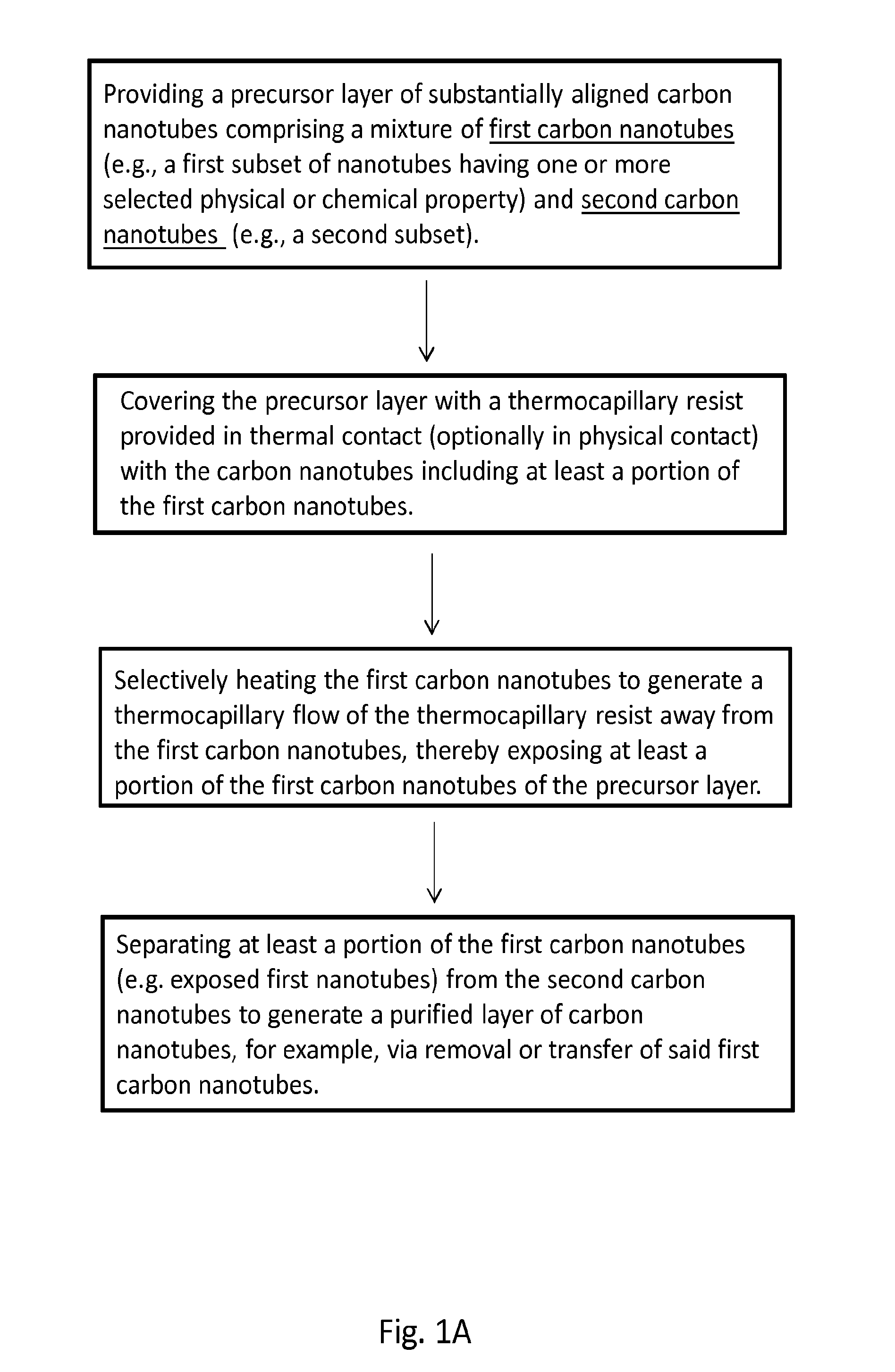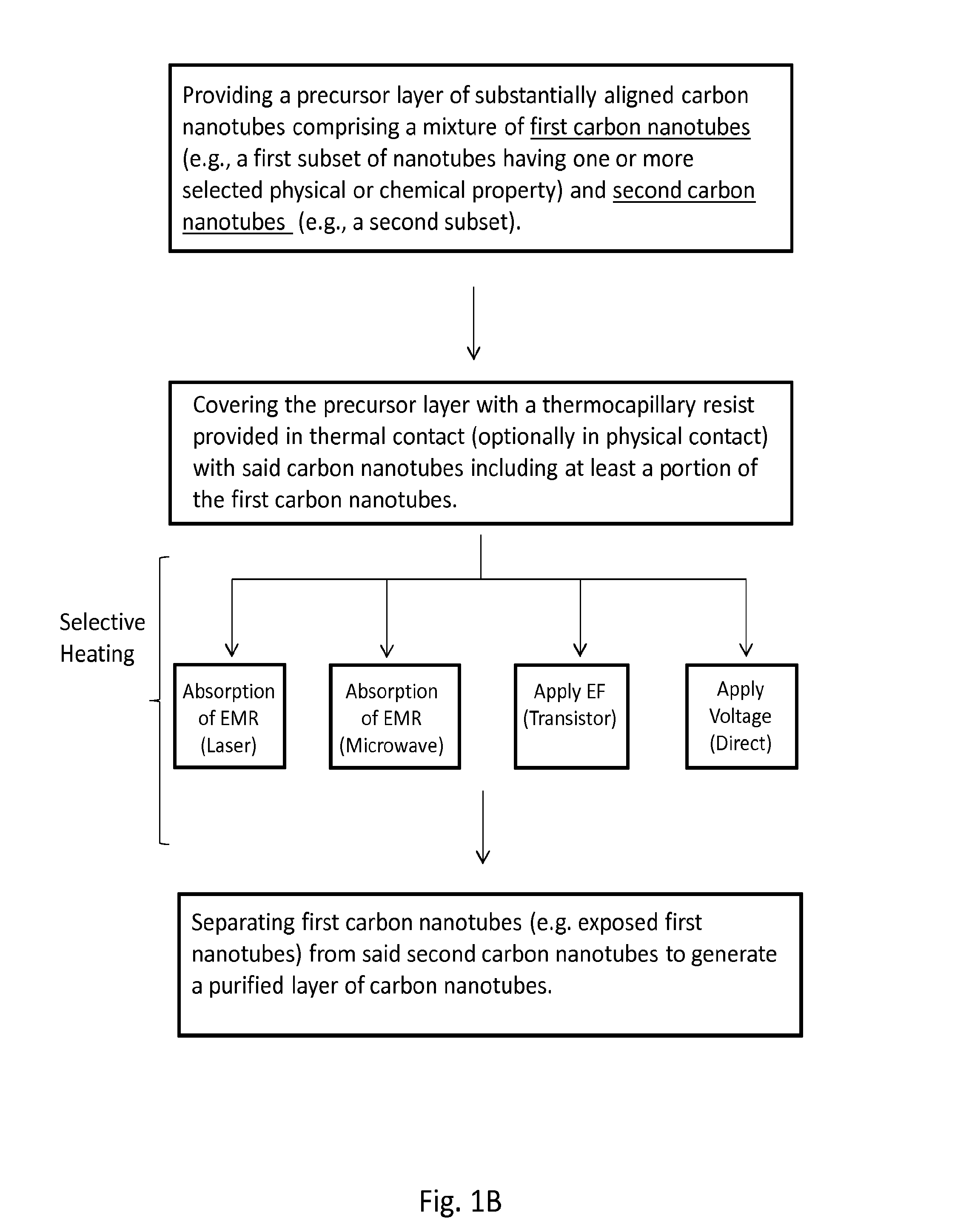Purification of carbon nanotubes via selective heating
a carbon nanotube and selective heating technology, applied in the field of carbon nanotube materials, can solve the problems of increasing static power consumption, reducing the on/off ratio of devices, affecting the commercialization of these systems, etc., and achieves the effects of low operational voltage, convenient direct comparison, and easy removal
- Summary
- Abstract
- Description
- Claims
- Application Information
AI Technical Summary
Benefits of technology
Problems solved by technology
Method used
Image
Examples
example 1
Using Nanoscale Thermocapillary Flows to Create Purely Semiconducting Arrays of Single Walled Carbon Nanotubes
[0166]Among the remarkable variety of semiconducting nanomaterials that have been discovered over the past two decades, single walled carbon nanotubes (SWNTs) remain uniquely well suited for applications in high performance electronics, sensors and other technologies. The most advanced opportunities demand the ability to form perfectly aligned, horizontal arrays of purely semiconducting, chemically pristine SWNTs. Here, we present strategies that provide this capability, in which nanoscale thermocapillary flows in thin film organic coatings serve as highly efficient means for selectively removing metallic SWNTs from electronically heterogeneous aligned arrays grown on quartz substrates. The low temperatures and unusual physics associated with this process enable robust, scalable operation, with clear potential for practical use. Detailed experimental and theoretical studies ...
example 2
[0347]Aligned single walled carbon nanotubes (SWNTs) are well suited for applications in high dynamic range RF electronics, low-noise linear amplifiers, mixed-signal devices and sensors. During CVD growth of aligned tube arrays both metallic and semiconducting tubes naturally grow at a statistical ratio of 1:3. Many electronic device applications require arrays of purely semiconducting SWNTs. The presence of metallic nanotubes degrades the device electronic properties, impeding high performance. In the example above, we introduced nanoscale thermocapillary flow (NTF) processing in thermal resists for complete, selective removal of metallic SWNTs from CVD arrays. Here, we explore three distinct purification paths with a focus on complete process development, modeling and scalability. Microwave initiated NTF, laser initiated NTF, and direct laser ablation were assessed in detail. We have shown while all the techniques offer promise, microwave excitation is the most promising and can p...
example 3
Laser IR Based Approaches to Induce Thermocapillary Flow
[0381]A schematic of the IR-based TcEP process is presented in FIG. 68. SWNTs were grown via CVD on ST-cut quartz. A 25 nm amorphous film of α,α,α′-Tris(4-hydroxyphenyl)-1-ethyl-4-isopropylbenzene, a small organic molecule, is deposited onto the substrate. This material, hereinafter referred to as the thermocapillary(Tc) resist, was chosen for its thermal properties, resistance to RIE, as well as its ability to form a uniform and continuous ultrathin film on SWNTs and quartz. In addition, the detailed mechanisms behind thermocapillary flow of this material have been thoroughly explored in previous publications. Background heating of 65° C. was uniformly applied to the substrate, decreasing the viscosity of the Tc resist and promoting thermocapillary flow. The SWNTs were exposed using a λ=2500 nm pulsed infrared laser with a pulse duration of 10 ns and repetition rate of 1 kHz focused to a 5 μm beam spot size. The beam was raste...
PUM
| Property | Measurement | Unit |
|---|---|---|
| length | aaaaa | aaaaa |
| thickness | aaaaa | aaaaa |
| frequency | aaaaa | aaaaa |
Abstract
Description
Claims
Application Information
 Login to View More
Login to View More - R&D
- Intellectual Property
- Life Sciences
- Materials
- Tech Scout
- Unparalleled Data Quality
- Higher Quality Content
- 60% Fewer Hallucinations
Browse by: Latest US Patents, China's latest patents, Technical Efficacy Thesaurus, Application Domain, Technology Topic, Popular Technical Reports.
© 2025 PatSnap. All rights reserved.Legal|Privacy policy|Modern Slavery Act Transparency Statement|Sitemap|About US| Contact US: help@patsnap.com



